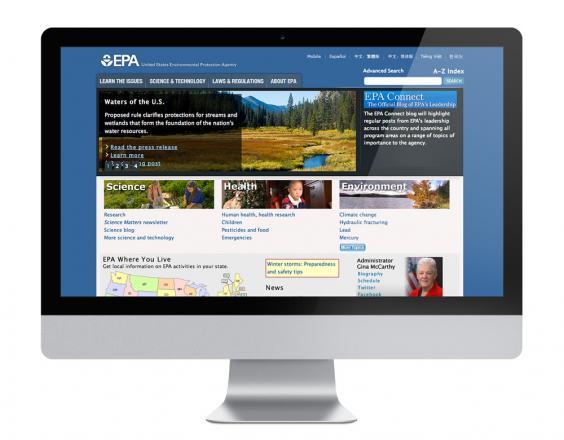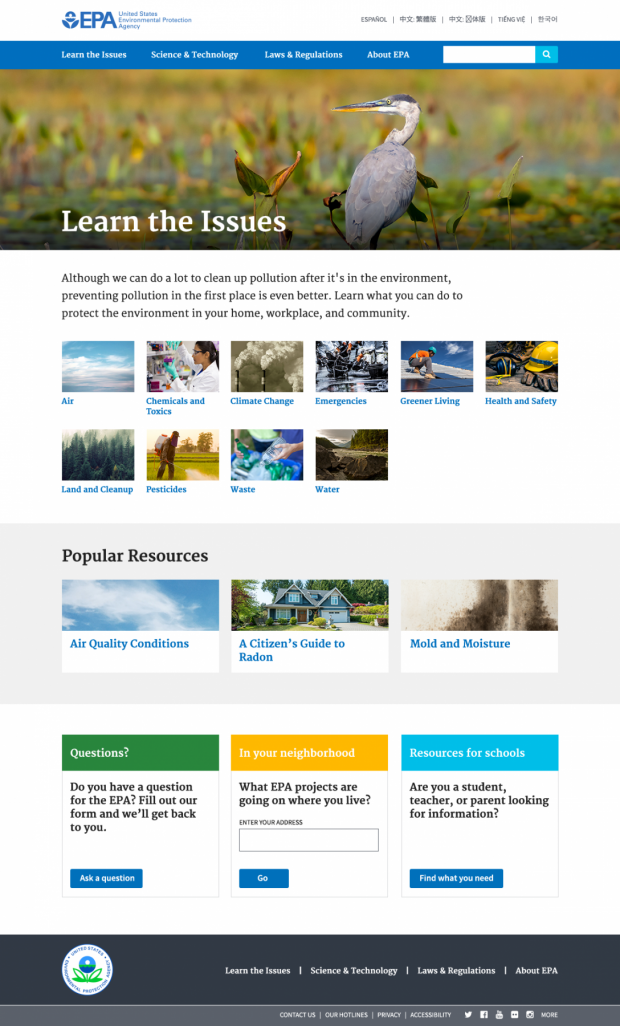 Support for Drupal 7 is ending on 5 January 2025—it’s time to migrate to Drupal 10! Learn about the many benefits of Drupal 10 and find migration tools in our resource center.
Support for Drupal 7 is ending on 5 January 2025—it’s time to migrate to Drupal 10! Learn about the many benefits of Drupal 10 and find migration tools in our resource center.As the flagship website of the U.S. Environmental Protection Agency, EPA.gov represents the diverse work of tens of thousands of EPA employees in their mission to protect the environment. EPA came to Forum One to develop a new Drupal-based version of EPA.gov to unify their web presence under the “One EPA Web” initiative. We redesigned and rethemed the EPA homepage and created a centralized online experience that helps EPA’s site visitors accomplish their tasks more quickly, and lets EPA’s content managers do their jobs more effectively.

Cohesive Look, Targeted User Experience
Our team worked with EPA to implement a clean, simplified design for the epa.gov homepage, with elements carrying over to key site sections. These design improvements increase the site’s usability and consistency, grouping and streamlining access to popular content, and implementing a common footer across site pages. The new design also optimizes the site’s responsiveness across devices, and improves its accessibility for people using assistive technologies.
Consistent Quality and Design Flexibility
With a large and distributed team of 300+ content managers, EPA needs tools to organize people and enforce quality standards. Forum One created a number of standard page layouts in Drupal, supported by predefined design tools that let EPA’s content managers create and plug-in site components as needed. This keeps the overall design consistent while giving each team the flexibility to present its unique content. We also used Drupal’s Organic Groups and State Machine modules to create groupings of editorial teams and structured workflow tools to aid editors in reviewing content for timeliness and accuracy.
Powerful, Scalable Drupal Technology
Our team is continuing to work with EPA to provide Drupal support and prioritize ongoing enhancements to the Drupal technical architecture to improve the experience for site users and content managers. With Drupal, EPA has gained powerful capabilities to present a more consistent online experience, and respond more nimbly as user needs and content priorities change.
Technical specifications
Organic Groups
All content on the EPA site belongs to a “web area”. These are, essentially, topic areas. For the end-user, these are exposed as breadcrumbs and as an essential component of the navigation of the site. Site subnavigation always flows from a web area parent. Internally, site maintenance duties are largely divided on a per-web-area basis. Editors typically “belong” to one or more web areas and may take different roles in different areas as, for instance, an “author” in one area and an “editor” in another. The Organic Groups module provides a convenient way to group the content in this way and and provides permissions so as to grant users only the permissions appropriate to their role in the group.
Panelizer
EPA’s website has evolved over many years to contain a wide array of content with different presentation needs. The existing site was largely built from static HTML which, while presenting significant drawbacks, afforded editors almost infinite flexibility in how to display their content. With such a large body of existing content and thousands of content editors it was important to retain some of that flexibility even while we sought to improve such things as the usability, maintainability, and consistency of style. Panelizer allows EPA’s content editors to construct a wide array of pages and layouts from a pre-defined, responsive “toolkit” of options developed for their needs, customizing the display on a per-node basis.
Fieldable Panels Panes
Fieldable Panels Panes (FPP) makes it easy to build new component types that content editors can embed on their pages. Things like lists of nodes or slideshows. Think of it like the Paragraphs module for Panels. With a little custom work we now allow editors to create reusable FPP entities that are added to a Web-Area-specific library of panes (useful for things such as a common sidebar element that they want to feature on multiple pages).
State Machine
State Machine allows EPA to enforce a complex publishing workflow on all content. This includes supporting multiple simultaneous forward revisions, email notifications at different workflow steps, automatic publishing and unpublishing and more. It required significant custom work to achieve the end result, but State Machine’s pluggable, API-driven architecture allows a lot of flexibility compared to something like Workbench Moderation. Now it serves to ensure content does not get published until vetted by the appropriate users, and the automatic-unpublishing workflow ensures content receives regular updates.
Media / File Entity
File Entity allows EPA to attach metadata such as number of pages, document IDs, captions, keywords, etc, to their files. Additionally, it allows greater control over the output and rendering of these files so that EPA can meet agency and Federal guidelines ensuring such things as images getting captions and PDFs getting links out to PDF viewers. Furthermore, the Media module gives editors a way to find and reuse media throughout the site. Unfortunately, while acknowledging the hard work (and frankly fairly heroic efforts) of the large team of people maintaining the Media module, it has been, and continues to be, one of the most painful features of the site. Media’s WYSIWYG integration in particular has significant bugs and limitations. For our D7 sites at Forum One we’ve lately had much better success with Scald and Asset modules. I am optimistic on the future of Media in D8.
Environmental Protection Agency - https://www.epa.gov/
Molly Mattessich
Joey Tackett

